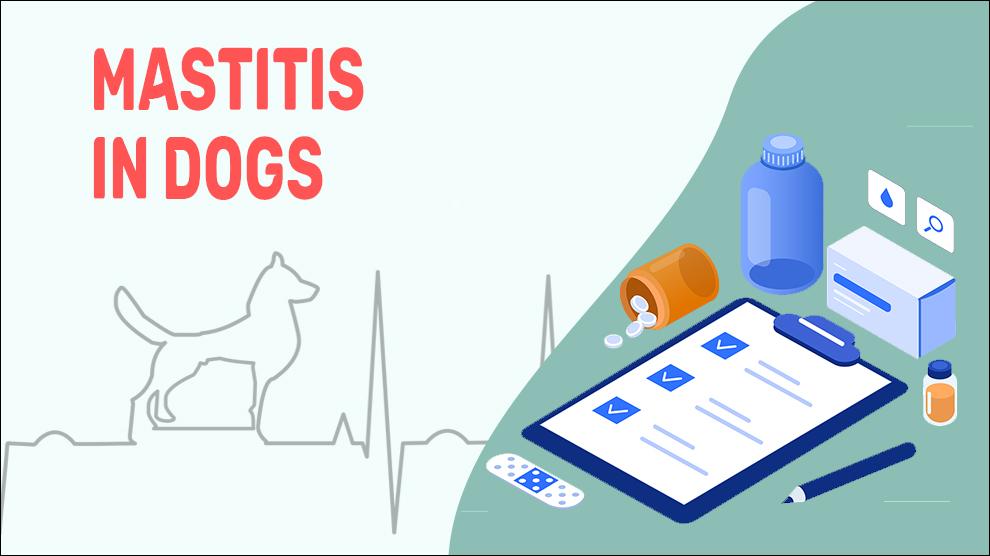The term ‘Mastitis’ is used to express inflammation of lactating mammary glands.
In most cases, infection is the main reason for mastitis. Trauma to the mammary tissue or nipple (teat canal) permits bacteria (in rare cases, fungi) to penetrate the teat canal, ascending inside the mammary gland. Female dogs living in unhygienic conditions will be exposed to parasites, pathogens, and other allergens, making them more prone to this infection.
Sometimes, mastitis can be observed in non-infectious causes such as secondary to galactostasis or extended periods of milk stasis (clogging) without removal of milk or trauma to the mammary gland.
Prolonged periods of milk accumulation without removal can happen because of sudden weaning (clogging due to unnecessary accumulation of milk within the gland) or due to the death of the puppy. Postpartum female dogs are most affected but it rarely occurs in pseudopregnant dogs too. The inflammation of mammary glands may be a clinical sign of breast cancer so it is better to check with the vet when you notice the first signs of mastitis.
Symptoms Of Mastitis
- Breasts that are red, swollen, or painful
- Discolored or bruised breasts
- Reluctance to allow nursing
- Swollen, red teats
- Decreased milk production
- Neglect of puppies/Poor growth in puppies
- Discolored or bloody discharge from the glands/ blood or pus in teats
- Loss of appetite
- Vomiting
- Lethargy
- Fever
Treatment Options For Mastitis
The treatment protocol is to reduce the spread of infection/inflammation and decrease the damage to the mammary tissue.
- Oral antibiotics
- Anti-inflammatory medications
- Pain Control: Medications such as NSAIDs
- Acute Septic Mastitis - Antibiotics, warm compresses, and milk expression from the infected teat.
- Galactostasis - Food and water intake will be carefully monitored, and diuretics and/or hormonal therapy.
- Surgery: In rare cases
Home Remedies For Mastitis
Cabbage Leaf Compress:
Cabbage leaves (usually chilled) may be recommended to help with pain, inflammation, and breast engorgement. Apply a bandage around your dog's body or fitted cloth to hold the cabbage leaf (Peel off the outer layer of leaves) in place for at least 2 hours. This can be alternated with hot and cold compresses.
Prevention Of Mastitis
- The most reliable way to prevent mastitis in dogs is spaying. Mastitis is very rare in spayed female dogs.
- Keep the puppies’ nails short to decrease the trauma to the breasts.
- Rinse the skin with saline twice a day (1 teaspoon of salt in 2 cups of cooled boiled water).
- Warm or cold gel compress enfolded in a clean cloth can be used to prevent inflammation. Pat the skin dry afterward. Apply the compress for no more than 5-10 minutes at a time.
Affected Breeds Of Mastitis
Female Dogs
Additional Facts For Mastitis
Causes:
- Ascending infection via teat canals.
- The trauma inflicted by the puppy's toenails or teeth on the teat canal or breasts.
- The spread of systemic infection originated elsewhere in the body.
- Poor hygiene.
- Extended periods of milk accumulation in the gland without milk removal - sudden weaning or due to the death of puppies.
Morbidity:
Clinically Mastitis is categorized as acute, chronic, or subclinical.
Acute Mastitis: Mastitis that crops up out of the blue is called acute mastitis and often presents with apparent clinical signs.
Chronic Mastitis: This has a gradual onset and subtle symptoms that worsen over time. In fact, chronic mastitis is a sequela of acute mastitis connected with duct ectasia. Plasma cell mastitis is a variant of chronic mastitis, characterized by plasma cell infiltration and duct expansion.
Subclinical Mastitis: This is always asymptomatic and may only be identified when the mother dog neglects the puppies or puppies fail to grow at a normal rate.
Diagnosis:
- Complete blood profile and
- Milk cytology/culture of the dog’s milk.
Mortality:
Mastitis is not potentially life-threatening and there is no documented mortality rate.
Prognosis:
The prognosis for mastitis is really good. As the existing condition is not life-threatening, no rigorous treatment is usually necessary. However, relapse is possible following medical treatment in affected dogs. Proper hygiene and home care are the best defenses against future recurrences.
When To See A Vet
Contact your vet right away, if you notice any of the following:
- She is not comfortable nursing her puppies.
- Breasts that are red, swollen, or painful/ Swollen, red teats.
Food Suggestions For Mastitis
- Fresh, lean protein (Lean ground beef, White-meat skinless chicken, or turkey).
- Antioxidants - Blueberries, blackberries, Steamed broccoli, spinach, cooked yellow squash, kale, and green beans.
- Low-carb dog food/ peas, sweet potatoes, squash, yams, pumpkin, etc.
- Iron: Lean meats like ground beef and lamb, fish, such as sardines and salmon, pumpkin, carrots, and leafy greens.
- Vitamin C and bioflavonoids: Brussel sprouts, spinach, broccoli, kale, pineapple, papaya, strawberries, etc.
Conclusion
The prognosis for mastitis is good and symptoms usually resolve in 2-3 weeks with prompt treatment.
Mild mastitis cases have an excellent prognosis. Acute septic mastitis can still have a good recovery with immediate and aggressive treatment.
Galactostasis mastitis doesn’t cause any immediate risk but should still be examined by your veterinarian. When the hormone levels are normalized, the dog would be relieved of the condition.
Dogs with serious mastitis, dogs can still have a good prognosis as long as adequate treatment is initiated quickly. The prognosis is guarded only when the dog develops a blood-borne systemic infection.

















